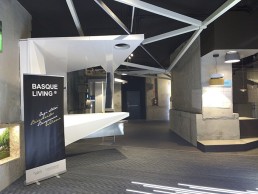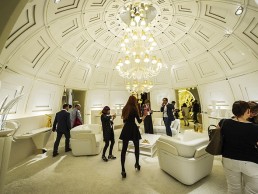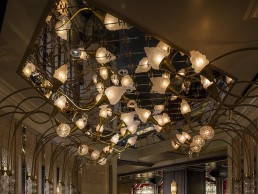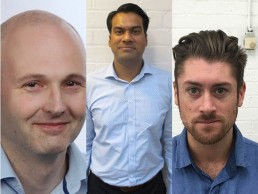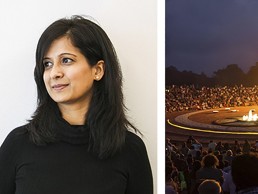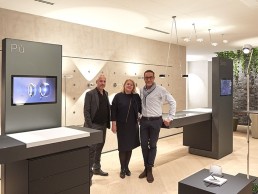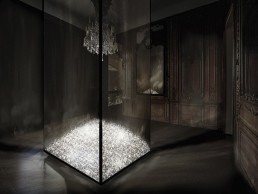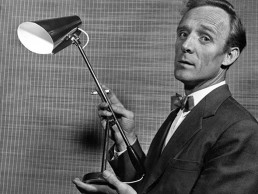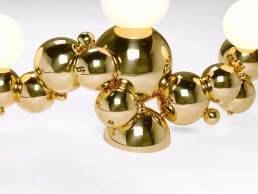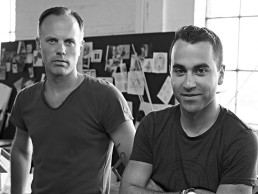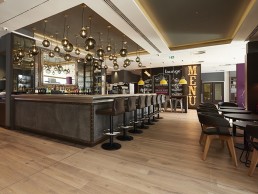B.lux opens new showroom
(Spain) - B.lux displays new lamps at Basque Living, the Cluster Habic showroom in San Sebastián.
Basque Living is a 250 sqm area sponsored by Habic, a cluster association for the home habitat industry located on the ground floor of the Tabakalera Building in the Basque city of San Sebastián. As a member of Habic, B.lux is showing its latest in contemporary lighting design, along with 22 other member companies like Ondarreta, Sellex and Treku.
The new showroom is a meeting place designed for interaction, as well as to explore ideas and especially to exhibit the latest design trends. It is intended not only for consumers, but for professionals and opinion leaders as well. It is a highly appealing space that allows Basque companies to project their image abroad.
As Basque Living, B.lux is showing some of its latest collections in decorative and architectural lighting, such as Aspen, Overlay, Keshi, R2 and Anvil System. The showroom, which is supported by the Guipúzcoa Official Associationo of Interior Designers, opened its doors in October 2016 and is open to visitors seven days a week.
Key themes for Salone del Mobile.Milano
(Italy) -The Salone del Mobile.Milano prepares for the international limelight with its 56th Exhibition.
Running between Tuesday April 4 and Sunday April 9 at the Fiera Milano Rho, key themes for the show include Furniture and Furnishings, Lighting and Workspaces. The event confirms its place as the benchmark for quality and innovation with the broad and comprehensive range of products on offer – from furniture and furnishings to lighting and workspaces – and two concomitant events, as well as its place as a forum for ideas.
Some 2,000 exhibitors will be showing their wares across a display area exceeding 200,000 m2. These impressive figures, along with the thousands of products being unveiled for the first time, confirm the Salone del Mobile’s enormous value as an international showcase for creativity and a forum for industry professionals, with more than 300,000 visitors expected to attend from over 165 different nations.
The exhibition is open to industry professionals every day between 9:30 a.m. and 6:30 p.m. It is also open to the general public on Saturday and Sunday.
Chairman Roberto Snaidero says: “A showcase for Italian and international furnishing excellence, the Salone del Mobile is putting the finishing touches to its fifty-sixth edition, which once again offers a unique opportunity for world industry leaders to unveil their products. The wide, exclusive range of commercial offerings on show attracts more than 300,000 industry visitors from over 165 countries, as well as premium media outlets from around the globe and of course the general public. Our close partnership with the city of Milan is of vital importance, confirming the city and the event’s status as capitals of design.”
The Salone Internazionale del Mobile is subdivided into three sections: Classic, Design and xLux, a sector dedicated to timeless luxury reinterpreted with a contemporary touch, which launched successfully last time round. Biennial events taking place alongside the Salone offer enormous synergies: Euroluce in Pavilions 9-11 and 13-15, and Workplace3.0 in Pavilions 22-24, as well as the International Furnishing Accessories Exhibition and SaloneSatellite.
Euroluce, which is being staged for the 29th time this year, showcases the best the world lighting market has to offer, from decorative products to technical lighting for application in industrial, street, entertainment and hospital system environments, home automation and lighting systems, sources and light technology software. As ever, the event retains its focus on energy saving, environmental sustainability and light pollution.
Workplace3.0 – on for the 17th time – is a leading-edge concept-driven exhibition dedicated to workspace design and technology; an event that responds to rapid changes in the world of work and emerging market needs.
The finest furnishings for offices, banks and insurance companies, post offices and public environments will be on show, along with seating for offices and communities, components for acoustics, internal partitions and coverings, furnishings for offices, audio/video technology, technical installations and security systems.
For the twentieth year, the SaloneSatellite will be offering a place for young people selected from five continents, business people, architects, interior designers and the press to meet in Pavilions 22 and 24; the general public may enter free from Cargo 5.
Alongside the many products on show, two biennial fair events are dedicated to lighting and the workplace. The first, curated by Simone Ciarmoli who curated Before Design: Classic at the last edition of the Salone del Mobile.Milano, is titled DeLightFuL (short for Design, Light, Future, Living). The Exhibition features the presentation of an independent fantasy-inspired short film from multi-award winning director Matteo Garrone.
The other event, A Joyful Sense at Work, curated by Cristiana Cutrona, conveys a vision of the evolving future scenario of office environments, presenting innovative content and approaches to the design of office products and workspaces through three installations, each of which features the cultural specificities of the three areas from which their international architect designers come: America, Asia and Europe.
In its second edition space&interiors, the only event linked permanently with the Salone del Mobile.Milano and devoted to architectural finishes. The venue is The Mall, Porta Nuova, right in the heart of Milan’s Brera Design District, and the event will showcase surfaces, flooring, doors and internal finishings in an evocative setting curated by the Migliore+Servetto Architects practice.
From Tuesday 4th April to Saturday 8th April 2017 space&interiors will shine the spotlight on a sector that is attracting increasing attention from designers and architects. space&interiors 2017 will again be staging meetings and workshops offering valuable cultural insights, while a special lounge area will host Archicocktails, the event where visitors discuss the latest trends in the building construction industry with some of the leading names in architecture and design. The visually stunning location will be divided into separate spaces, with a strong focus on computer graphics. The theme of the event is lightness.
And to top off the 2017 edition of space&interiors, an exhibition entitled “Absolute Lightness” set against a cutting-edge digital and interactive backdrop will showcase the superb finishes used in modern architecture.
Beauty & Essex, US
Focus Lighting uses decorative lighting to bring a sense of class and glamour to The Beauty & Essex restaurant - the newest addition to The Las Vegas Strip.
The Beauty & Essex at The Cosmopolitan is one of the latest restaurant / lounge destinations to hit the Las Vegas Strip. A sophisticated, jewel-toned spot featuring vintage décor, it offers New American plates, drinks and wine. The second of it’s kind, the Las Vegas branch is very much an extension of the brand, evoking in its guests the sense that they are dining inside of a well-curated jewellery box.
Staple features from Beauty & Essex New York, such as the functioning storefront Pawn Shop, Pearl Lounge, Mirror Bar, Locket Room and private dining room have been re-established in Las Vegas, while new features such as a 40ft long Locket Wall and a pair of ‘diamond rings’ in the private dining room, bring new life to the concept.
Focus Lighting was introduced to the project through the design architect Rockwell Group to implement both an architectural and decorative lighting scheme. The design intent was very clear from the beginning, with decorative lighting fixtures key to making the space feel like the inside of a jewellery box – they are used throughout as the apparent source of light.
JP Lira, one of Focus Lighting’s principal designers, was involved in the project from the beginning and told darc: “Our team worked closely with Rockwell Group to make sure every element of the design was executed as expected. Finishes in each room were carefully selected and then tested full-scale to assure their details were visible in low light environments.
“One early challenge was finding ways to use the Peacock Room’s existing light fixtures. We couldn’t remove or relocate them so we had to integrate them into the ceiling lighting design for the new floor plan.
“Additionally, working with extremely tight wattage requirements gave us fewer opportunities to use halogen and incandescent lighting, which was a challenge considering the client’s vision for the space called for a lot of decorative lighting and nice, low dimming.”
Both decorative and architectural lighting is used to reinforce the sense of luxury guests feel at Beauty & Essex. Customised decorative fixtures accomplish this outwardly, while architectural lighting subtly brings all of the restaurant’s jewel-inspired features and finishes to life.
“We used light to make every little detail feel luxurious and significant, enveloping guests in a world of gold, pearl and crystal,” said Lira.
Each room has its own decorative lighting fixture that complements its individual aesthetic. In the Peacock Room, gold chandeliers create a rhythm alongside details in the room’s wallpaper and Locket Wall. In the Pearl Lounge, soft glowing light from a bowl uplight, showcases the subtle elegance of the room’s pearl ceiling canopy. For the private dining room Focus Lighting worked with Rockwell Group and Canopy Designs to create a set of custom pendants – two ‘diamond’ rings. “We agonised over every detail,” said Lira. “From the shape and thickness of the crystals to the quantity and placement of the LEDs – producing a stunning light fixture that emulates the sparkle and elegance of a diamond ring.”
While the decorative fixtures look and feel like pieces of jewellery themselves, architectural lighting is used to enhance the sparkle and shine in every finish throughout the space. The lighting in this project is what ties everything together and creates an immersive experience.
“As a result of constant coordination and attention to detail the final design was a great success,” said Lira. “What was really unique about this project were the number of important details we needed to accent, in order to produce that feeling of immersion. We spent a lot of time on-site meticulously aiming and adjusting every fixture in order to meet that goal.”
During one site visit Lira noticed that the gold wallpaper pattern in the Pearl Lounge wasn’t reflecting light as intended. As a solution, he suggested that the pattern be painted over with gold Sharpies. Using an instructional video created by Lira, staff from the restaurant outlined the wallpaper’s pattern with Sharpies, substantially increasing reflectivity!
The transition from the gritty storefront pawn shop to the restaurant, where every little detail works to create a magical immersive experience from beginning to end is what makes this project unique.
Focus Lighting is currently designing the lighting at a third Beauty & Essex in Los Angeles, California.
Chelsom strengthens Operations team
(UK) - With a trio of new appointments, Chelsom strengthens its Operations team.
Chelsom has appointed a highly experienced Operations Director, Eddy McLoughlin, to facilitate the continued expansion of the Chelsom brand from an operational perspective. The new appointment accompanies a series of high profile international project wins and a significant increase in sales across the global hotel, marine and leisure sectors.
With an extensive professional background, Eddy brings to Chelsom considerable experience in international logistics, site operation development and business process improvement, developed in both large corporate and smaller owner-managed businesses. His career to date has provided him with considerable engineering experience and sound electrical knowledge having worked in project driven environments managing large UK and international contracts.
Ganesh Prasad has been appointed as Head of Technical at Chelsom. Key responsibilities include providing technical client support, product design engineering, international regulations and certifications, supply chain liaison and onsite installation.
Ganesh holds a MSc in Light and Lighting and is a graduate member of CIBSE and the Society of Light and Lighting. He has experience in UL and ETL and is well versed in lighting design software including Dialux and Autocad. His experience has been gained working in India, Dubai and the UK.
These two exciting new appointments are further supplemented by the addition of Marc Mcilwham as Electrical Project Engineer, a new position created to give increased on-site technical support to the world wide contract client base. The appointment will enable the Chelsom team to attend sites either for assessment and quotation purposes or to supervise on-site assembly and installation. As a qualified electrician Marc also adds technical expertise to in-house custom product design.
Managing Director, Will Chelsom commented: “We have been very diligent in our search for the right people and have no doubt that the new recruits will bring plenty of expertise to Chelsom and in doing so will be a huge asset to the growing technical and operations team specifically. We recognise the necessity to service and support our clients better than ever, ensuring that we have the optimum infrastructure in place to allow us to do so. We are delighted to welcome Eddy, Ganesh and Marc to the team at a critical time for the company ready to tackle the opportunities ahead in 2017 with some of our biggest and most challenging projects to date in the pipeline.”
dpa lighting consultants expands
(UAE) - dpa's Dubai studio welcomes Senior Designer Deeksha Surendra to expand its team in the Middle East.
In the past, Surendra has worked in lighting design and architecture practices in India and UK. After graduating in architecture and having worked in architectural practices for several years, Deeksha's interest in the symbiotic nature of art and architecture led her to pursue a Master's degree in a multidisciplinary art course in Edinburgh.
It was here that she was introduced to lighting design, baking and running. She now pursues at least two of these three at any given time. Surendra is also a registered member of the Council of Architecture in India.
Occhio opens Cologne store
(Germany) - Occhio opens innovative flagship store in Cologne, pointing the way to the future of light.
On November 10, 2016 Occhio, the Munich lighting and design company, opened its new flagship store at Kaiser-Wilhelm-Ring in Cologne. The multifunctional store concept, planned and implemented together with the architecture office eins:33, offers consultation and sales at the highest level and unites a showroom and information platform in a unique lighting and brand experience.
More than 200 enthusiastic guests celebrated the opening of the new rooms in Kaiser-Wilhelm-Ring with the Occhio team and experienced an exciting mix of architecture, lighting design and products. On more than 330m² and over 2 floors the new Occhio store CGN presents a unique interactive brand and experience world providing a showroom and information platform for final customers, professionals and Occhio retail partners alike.
The flagship store is divided into three areas. On the ground floor the visitor is welcomed in an invitingly bright showroom. 'Space stations' are used to present diverse luminaire and spotlight series and invite you to get to know the products interactively. The eye-catching green stone wall with real plants is a symbol of Occhio's evolutionary philosophy and rounds off the room's design concept.
At the rear of the store there is a large multifunctional area for training courses, lectures and special exhibitions.
An inspiring living area awaits the customer on the upper floor. In a cozy atmosphere the visitor experiences Occhio luminaire and spotlight systems in realistic application and the effect of light and quality of light as at home.
The Occhio Store Cologne is one of the two company-own flagship stores (Cologne and Munich) and the pilot for the new »store by« concept, which is being implemented throughout Europe with a selective circle of retail partners. Occhio stores have already been successfully opened and established with exclusive retail partners in Paris, Luxembourg, Prague and Antwerp.
"Our endeavour is to develop innovative and unique product families for holistic lighting design", says Axel Meise, Designer and Proprietor of Occhio. "I will be delighted if we are able to communicate the added value of good light to visitors to the new Occhio store in Cologne. With our products we would like to enable people to interact naturally with light thus becoming the lighting designers of their own living environment. For quality of light means quality of life."
Artemide at Musée des Arts Décoratifs
(France) - A new exhibition showcasing the works of renowned architect Jean Nouvel and Italian lighting experts Artemide at Musée des Arts Décoratifs in Paris launched in November 2016.
The “Jean Nouvel, mes meubles d’architecte – sens et essence" exhibition, running until February 2017, displays over 100 works by Nouvel, who is considered a master in his field, and includes special products designed with Artemide.
The furniture and lighting collections interact with the museum’s permanent objects and collections through the contrast of light. Sections of the exhibition are revealed to visitors through the use of light and shadow, which creates different perspectives and atmospheres within each space.
The works on display include Objective and Equilibrist; lighting projects characterised by their high-tech yet effortless forms born from the long-standing partnership between Jean Nouvel and Artemide. Both designs are smart, poetic and an expression of shared design values and of the ongoing pursuit of a new way to conceive light.
The partnership between Artemide and Jean Nouvel has resulted in significant lighting projects for architectural works, such as the Louvre in Abu Dhabi and the Château La Dominique. Both of these projects are a testament to Artemide’s skill and capabilities of producing high-tech products that convey great craftsmanship and high-quality manufacturing.
The collaboration characterises shared objectives and visions, resulting in design research which offers an interaction between man, light, and landscape.
Northern Lighting celebrates Birger Dahl centenary
(Norway) - November 24, 2016 marks 100 years with Birger Dahl for Northern Lighting.
The award-winning designer was a pioneer of contemporary Scandinavian design, with Northern Lighting housing three of his design in its collection.
Birdy 1952
In 2013, Northern Lighting relaunched Dahl's design classic under the name Birdy, taking care to preserve its main shape and features.
Dokka 1954
Pendant S/10053 originally was nicknamed "the girl" in reference to the round shape of a woman's body. Dokka was the first lamp Northern Lighting re-launched from Birger Dahl.
Dahl 1956
Dahl designed the pendnat lamp for the Norwegian Parliament building which was renovated after World War II. The newly launched version has been given the name Dahl to tribute to its creator and his centenary.
Rosie Li Bubbly
Inspired by soap bubbles and botroiydal hematite, the Bubbly series is an on-going exploration of the forces of attraction and other cluster patterns found in nature. Bubbly is available in polished and satin brass, oil rubbed bronze and polished nickel.
Zaha Hadid Architects opens Middle East office
(UAE) – New ZHA Dubai office opened in response to growth in demand from new and existing clients across the region.
Zaha Hadid Architects has announced the opening of a new Middle East office located in the Dubai Design District.
With 30 years’ experience in the Middle East and North Africa, Zaha Hadid Architects (ZHA) is collaborating with visionary clients throughout the region on sixteen transformational projects. ZHA’s new office within the district continues its longstanding commitment to the region.
A recipient of the 2016 Aga Khan Award for Architecture, ZHA marries concepts of connectivity with the tremendous advancements in design technologies, material development and construction practices. ZHA is working with the many diverse histories and cultures of the region to address important issues in a meaningful way – contributing to the development of more ecologically sustainable and integrated built environments.
Opening on 7 November, 2016 ZHA’s office in Dubai has been established in response to the solid growth in demand from new and existing clients across the region; providing even greater levels of assistance, coordination and communication with our increasing client base throughout the Middle East.
Zaha Hadid Architects Middle East
Unit 503, Building 8
Dubai Design District
Dubai, UAE
Gabriel Scott
Brought together by a bond thicker than blood, Gabriel Scott is a Montreal-based design studio comprised of Gabriel Kakon and Scott Richler, brothers-in-law and creative partners. Scott Richler met with Femke Gow at the Triode gallery in Paris, France, to talk design, inspiration and medieval artistry.
Tucked away in the streets of Paris on rue Jacob, Scott Richler stood amidst his studio’s geometric creations in the Triode design gallery, reminiscing on how he and his brother-in-law Gabriel Kakon, both from Montreal, Canada, came together creatively.
“Gabriel and I have similar backgrounds, both having gone to schools of architecture. When I graduated, I had a bit of a departure from that and went into jewellery, which then became other types of accessories like handbags, and I eventually found my way back to furniture. At that time, Gabriel was still studying architecture and we started to work together around 2004.”
The beginning of a very bespoke line for Gabriel Scott, the duo began by creating one off pieces such as large tables, things that couldn’t be reproduced without huge effort. This went on for a few years until they decided to treat furniture more like Richler had been treating jewellery or fashion, as something that could be reproduced and distributed. “Around 2011, we changed the thinking a little bit and started to produce pieces that had component based productions,” said Richler. In 2012, the pair moved away from sculptural pieces to launch a contemporary line of reproducible lighting and furniture fixtures as Gabriel Scott, including the Harlow, Welles and Kelly lighting series.
Gabriel Scott’s first piece of lighting was the Kelly, with chains cascading down in clean lines, an angular geometry that is seen across their collections. “I think you could say that what really came together at the birth of Gabriel Scott was adopting the languages of the pieces we had done previously in a bespoke method and applying the same aesthetic. Our aesthetic always revolved a lot around steel and brass treatment. These kinds of details were always there from the beginning.”
Shortly after the pair established themselves as Gabriel Scott, they opened a flagship store in New York. Why? “For obvious reasons, because it’s New York!” said Richler. Having already developed a deep client base in New York, Richler and Kakon had collaborations and relationships with other designers and architects in the area. “We were doing tradeshows and a lot of people were asking, so we set up a store out of both desire and demand. There really was a lot of demand for it and since we’ve opened, I can only say good things. We’ve had amazing feedback and our business has grown tremendously. New York is not just an American city so we have exposure to international markets. The showroom is also an impressive space, so it speaks for itself. It makes you look like you know what you’re doing.”
Not only is it the space itself but the collections housed within the New York showroom that are truly convincing of expertise in thoughtful design and craftsmanship, oozing a mature understanding of design crafted out of the their varied experience.
“The Welles series was originally very sculptural, but was resolved in a technical way like a jeweller. We use a lot of the same techniques that we’ve used in the past. Some of our stuff is really very complicated, like blowing the glass for the Welles Glass, but then we try to resolve the details so that they can be machine made first and then assembled by artisans. You don’t have to be a jeweller to assemble them, but you have to be a very good glass blower to manage to get those forms.”
Gabriel Scott’s latest collaboration with London-based tattoo artist Maxime Buchi demonstrates the versatility of technique and stylistic detail that the studio includes in its work. Looking ahead to the launch of the new collaborative fixture, which was celebrated during London Design Festival at FBC London’s Francis Street showroom (turn to pg. 98 to find out more), Richler commented: “I had been following Maxime’s work for several years. At first I was drawn to the tattoo work, then I discovered and began to appreciate the nature of the whole cross discipline attitude that he promotes.” Buchi is very similar to Gabriel Scott in his approach to tattoos and line art, using the same style of geometric art in his refined aesthetic that could be described as a graphic modernist, scientific illustration of contemporary and classic art.
Buchi commented on the collaboration that seamlessly brought together tattoo art and product design: “Tattooing is before anything, a work in 3D. It has as much to do with space as with illustration. Working with the ergonomics of geomtry on the body to the geomtric quality and ergonomics of furniture was a step I always hoped to make and this collaboration made it possible. Scott understands my world perfectly and translated my ideas into objects with an absolute perfection.”
Modeled after the tetrahedron, a base element for all platonic solids, the varying line weights of Buchi’s drawings were interpreted in the varying thickness of the materials. The thin wires used to power and suspend the fixture juxtaposed against the thicker machined metal bars that create the inverted pyramid form relate back to Buchi’s work. The light source is located in the corners of the tetrahedra and are directed towards the hanging icosahedron in the centre, refracting and reflecting the light.
Richler commented on the development of this collection, a patterned version of the Welles Glass series: “You make a mould out of steel and then you weld it. The moulds have Maxime Buchi’s line and dot work inside, which leaves an imprint on the glass after it’s blown into the mould... And these moulds are big! To blow into them, you can’t actually lift them so you have to stand over them on a podium, or a stool, and blow. And there has to be two people, one to steady the mould and one to blow. The process of getting these kind of shapes is very medieval.
“I’ve tried to do it and I just can’t. To blow glass like that, you have to really push with everything. It’s a very physical process. Our glass is blown by an artisan in eastern Quebec who is from Czech Republic. He used to work for Lasvit and is one of the best.”
So with a background in jewellery, what draws Richler to bring the same attention to detail to the world of lighting? “Light kind of is jewellery,” he said instinctively. “In the same way that someone wears a jewel, a hotel or a home wears a light. It’s the piece that you notice when you walk into a room, for various reasons. It’s the only thing that floats. It’s the only thing in the room that really has an aura. It dresses the room.”
According to Richler, designing lights has no constraints. There are technical constraints to get a light to work but in terms of its form, it allows a designer to be very sculptural. “A coffee table has to be 17-inches high, or a chair has to hold weight and it also has to be able to have someone sit in it. You have to measure a person. There are more rules in furniture than there are in lighting. It really allows freedom of expression.”
As more and more people seem to be embracing this irreplaceable vitality of decorative lighting, Richler points out the danger of this phenomenon. “It happens in fashion as well, when shoes are really important to women one year, then bags, then jewellery. I think in terms of the interior design world, more indie designers have been producing very interesting lighting, which they weren’t before as it used to be dominated by Italian companies. The only danger is that it’s heavily saturated, so you have to be really special to stand out.”
Gabriel Scott’s designs set themselves apart by taking inspiration from anywhere other than designs within its own field. “I rarely get influenced by another piece of furniture or lighting,” said Richler. “It usually comes from outside of that. I usually see an interesting detail that I apply. For example jewellery designer Gaia Repossi who recently redid her Paris store with architectural practice OMA headed by Rem Koolhaus – it’s things like that, which influence me. Not in a literal sense, but it’s the subtlety or the detail in another medium, or something small in a piece of art. It’s almost always external, like the joining and wells and other details.”
This attention to detail is evident across the entire body of Gabriel Scott’s work, adding an element of intrigue to interior projects for which their products have been specified. Such projects include American department store Saks Toronto (March 2016), which features the Welles Long chandelier in blackened steel in the men’s department, specified by interior design duo Yabu Pushelburg for its sculptural quality and masculine aesthetic. This same fixture is also seen in Armani Chicago’s men’s store, completed in January 2015.
Elsewhere in the retail sector, the studio’s Harlow large chandelier in Alabaster white and satin brass is seen in the Bergdorf Goodman New York store (January 2015), and Century 21’s handbag salon in New York (April 2015). The pair have also worked with Yabu Pushelburg on several Four Seasons hotel projects including Toronto, Boston and Kuwait amongst others.
Gabriel Scott’s work holds history that lies in choices of colour and design intention while edging towards the future with its varying progressive forms. “Nothing we make is totally foreign, which is where the history lies,” said Richler. “Familiarity in anything is what is going to draw the person in, that little bit of what the work has in common with you, what is familiar to you, and what is new in it.”
Richler sees a recognisable style in Gabriel Scott’s work, indicating that the pieces come from one studio. They push the boundaries, all the while being aware of their audience and its needs. “We could be much more extreme and artistic in some way and create more sculptures, but we have to try to figure out what people want. We have to create something that people can really envision themselves having and knowing what to do with. So we take all that history and sensitivity and we try to make something fitting.”
In a combination of skill and natural instinct, Gabriel Scott finds itself at the forefront of what is current in design, without actually paying too much attention to trends. This is the mark of two true creatives who speak the same design language. Together, Richler and Kakon create that which appeals to the traditional using forms of the future to invite intelligent design into everyday life.
Frankfurt Premier Inn, Germany
UK hospitality group Whitbread celebrates its first hotel in Germany with an imaginative design for the Premier Inn by Hamburg-based interior architect JOI-Design.
JOI-Design was invited to participate in a competition to create a new design for the Premier Inn hotel brand that would be fitting for the German market.
A quintissentially British hotel chain and the UK's largest hotel brand, Premier Inn has more than 50,000 rooms and 700 hotels in the UK. It operates hotels in a variety of locations including city centres, suburbs and airports, setting the specialist firm of interior architects up for a significant challenge in carrying this reputation.
JOI-Design was advised about the launch of the British brand into Germany by Jeremy Scarlett (JSJ Design), the designer behind Premier Inn’s UK hotels. Co-managing Directors of JOI-Design Peter Joehnk and Corinna Kretschmar-Joehnk commented on the process: “Whitbread brought us to London for three days so we could gain an understanding of what the brand stands for in the UK. The concept we proposed won in September 2014, and we started our planning straightaway in October. The hotel opened in April 2016.”
The Frankfurt Premier Inn blends the traditional and the modern with a mix of natural timbers and rich, saturate colours. These are brought to life by vibrant accents of turquoise, sunshine yellow and violet. The result combines distinctive British style with a touch of humour, attention to detail and the comfort of an open-plan layout.
JOI-Design experienced Whitbread as an open-minded client during the competition phase, while the actual concept implementation proved a challenge, being so different to its UK properties. As the standard Premier Inn design premise had been tried and tested in UK hotels, the management didn’t feel it was necessary to make many changes for the German marketplace.
JOI-Design faced an uphill battle with many aspects to consider transforming their design into an award-winning hotel in Frankfurt. “The brief didn’t really change over time, but we refined our concept in response to the evolving requirements for operational effectiveness, marketing and value engineering,” said Joehnk.
Kretschmar-Joehnk added: “It was essential that our German perspective upon Britishness would be translated in a clever way, and the lighting elements were key to supporting this. We chose lights from a variety of British manufacturers and craftspeople, for example Original BTC, Made and Northern Lights, to help convey an authentic sense of aesthetics.”
As a contemporary take on a typical British library, the lobby is a multipurpose living space, welcoming guests into a modern lounge where busy young travellers can unwind, recharge and catch up on work. The tables in the thoughtfully designed work zone incorporate state-of-the-art data technology to support guests as they prepare for meetings or check emails. Large seating areas with classic Chesterfield sofas and comfortable armchairs invite guests to relax and linger, while open shelves separate the lobby, work zone and dining areas to create a degree of privacy.
Lighting was used to create a different ambience in each zone and enhance the distinct identity of each space. In the breakfast room, bar and restaurant, deep rich tones are accented in violet and turquoise. Other distinctive features include an eclectic assortment of pendant lights, a metal bar, riveted wall panels, and a wide variety of seating such as high-back armchairs covered in checked Burlington upholstery. The word Menu emblazoned in glowing marquee lights injects an energetic vibe that not only combines decorative appeal with way finding practicalities, but also accentuates the motel’s motto: “Walk in and enjoy”.
“Decorative lighting was hugely important for this project,” said Joehnk. “As the Premier Inn is the last in a row of three hotels along the same road, it was essential that our design helped the property stand out from its competitors. Our strategy was to attract attention from those outside by creating a playful and dynamic illumination concept that was highly visible.”
As with any project, challenges were faced in the process of bringing the brief to life. JOI-Design used lighting as an integral part of its strategy to convey the German perspective of Britishness. Beyond this, planning permission had already been granted for the building’s originally intended use as a boarding house, so JOI-Design was only able to make changes to non-loadbearing walls.
In addition, achieving comfortable ceiling heights in the public areas was difficult because of the way ductwork was orientated, affecting the way they could use decorative lighting. “Eventually, when we arrived at solutions that made everyone happy, we could finalise the placement of the decorative lights.”
Working with such a large client as Whitbread, with many tiers of decision making, posed challenges in its own right, while offering a cultural learning experience to both German and British sides.
JOI-Design’s work on Frankfurt Premier Inn is almost an exact representation of its original design concept. After achieving such a successful project, the most rewarding part remains its planned expansion of the brand into Germany, including the development of a new guestroom concept to be rolled out in one of the numerous properties.


